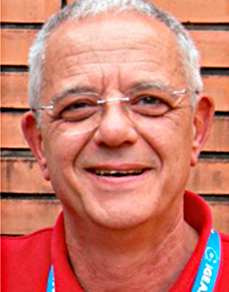The results obtained in the protocols illustrated in the previous number led us to continue our efforts in larger jobs, with results that were initially encouraging, but that later showed signs of unexpected torsions. In some larger jobs, during the repeated firing sessions, the arch had to be readjusted, since imprecisions appeared due to the release of internal tensions. In some cases, firing for stabilization before ceramic application mitigated the problem. In jobs on milled posts without perfect closure, this could even be acceptable, but on natural teeth it would definitely not be. We need to verify exactly how, when and to what extent these problems occurred, and how we could rectify them, or at least understand their limits.
In agreement with Sweden & Martina we devised a small study to clarify this situation. We constructed a model with four milled posts, and on this we produced three types of arch, so as to determine which was most controllable. The three ferrules were adjusted cold to assess precision both on the single posts and on the entire assembly, and they were then annealed in a ceramic furnace, performing a series of firings as if they were to be ceramicized, with checks every time they were taken out of the furnace and readjustments if necessary. In greater detail, ferrule A was normally adjusted when cold, always requiring further readjustments after the various firings, and becoming stabilized around the sixth firing. The precision after the firings was very good on one side and poor on the other.
Ferrule B gave the best results, with precision when cold, becoming stabilized after four firings, and finally with good precision.
Ferrule C was the most disappointing. The stabilizer bar that we expected to provide stabilization instead caused a series of torsions that made it unusable after just two firings.
Cold adjustment was already very difficult, and even more so after the first firing.
Conclusions:
- it is evident that a structure fabricated with a series of fusions contains tensions that tend to be released during annealing;
- it was noted that a particular design of the structure mitigates this contraindication (a robust linguopalatal band);
- it was determined that these distortions emerged only on very extended structures;
- experience teaches that with up to 2/3 of a complete ferrule, distortions can be controlled if an adequate design is chosen.
The precision when cold of laser-sintered Co-Cr is of a quality that is higher and above all predictable. It is only extended ferrules that show distortions after firing, with particular characteristics: all the ferrules tended to curve inwards at the level of the more distal elements. The use of a very long firing time for stabilization (e.g. 15/20 minutes at 980°/1000°C) could probably further mitigate this contraindication.
To verify if absolute stability could be achieved in such extensive jobs, we decided to experiment with a series of annealing processes on two Co-Cr arches milled from solid metal. Two structures were prepared, exploiting the previous scans, one with a stabilizer bar and one without.
The two structures were then subjected to the same treatment as the previous laser-sintered versions, with extremely positive results. No differences of precision were found between the arch with and the bar without the stabilizer bar, and only cold adjustment required a little extra work. We can conclude with these considerations: for normal routine jobs, laser-sintered Co-Cr is able to provide excellent solutions for all needs for precision in bridge structures, until a particularly sharp curve is reached, and our advice is not to exceed 2/3 of the arch. A milled element gives greater guarantees in all jobs calling for a complete ferule. Considering that as regards dental technology, these techniques are still very recent, and that therefore notable progress will be made with the many experiences of our colleagues, I believe that very soon we will be able to achieve constant dimensional stability even with the laser-sintered Co-Cr technique.
Stabilization firings
- Before consigning the job, a cycle of “distension” firings was performed in an argon atmosphere, consisting in:
- First firing from 0 to 450°C in 60 minutes, maintaining this temperature for 45 minutes. Heating up to 750°C in 45 minutes, maintaining this temperature for 60 minutes.
- Furnace off and cooling down to 600°C, then opening the furnace.
- Cooling down to 300°C, closure of the argon flow, extraction of the pieces.
This firing certainly optimizes the properties of the metal, but in dimensional terms it is absolutely insufficient.
Various experiences and a number of tests led us to consider a more incisive firing to be more advantageous: 1000°C for 10 minutes in a vacuum. This firing almost completely releases all the tensions, giving the piece 95% stability. Small corrections will be necessary as work proceeds, but these will be only minor, very similar to those to be encountered with fused precious metals.


